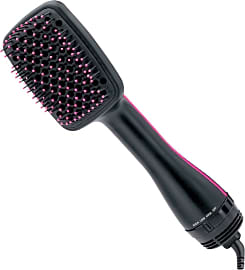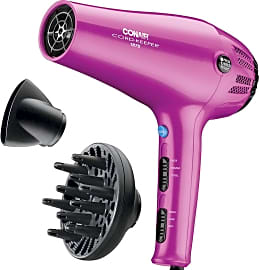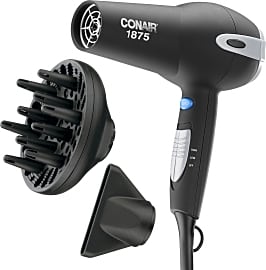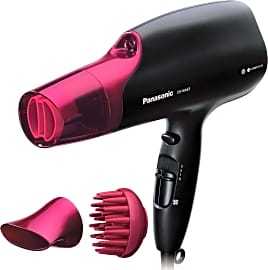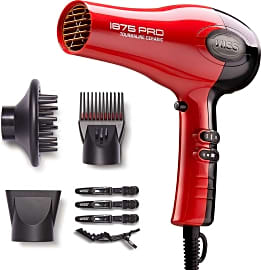The 10 Best Hair Dryers

This wiki has been updated 42 times since it was first published in May of 2015. Hair dryers have come a long way over the years, and today’s models feature advanced technology that reduces frizz and split ends, helps to retain moisture, and delivers beautiful, softer results. Their powerful motors get the job done quickly, so you’ll be out the door on time every day. Many are equipped with multiple speed settings and handy diffusers that distribute the airflow efficiently. When users buy our independently chosen editorial recommendations, we may earn commissions to help fund the Wiki.
Editor's Notes
April 14, 2021:
In this update, we removed the Drybar Buttercup and the John Frieda Full Volume due to availability concerns. We also removed the T3 Cura Luxe because its highest setting was too weak for many users and it had too high a price tag for what it offered.
We replaced the Conair Infiniti Pro with the Conair Cord-Keeper, which has many of the same useful features and also offers a retractable power cord, which makes it more convenient to store, especially if you have multiple corded devices kept in the same place.
The Revlon One-Step was added to the list in order to include an option with a built-in brush. This allows you to dry and detangle with a single device, which is nice for anyone who wants to save time and especially helpful for those who are only able to use one hand.
Also new to the list, the BabylissPro TT is a great on-the-go option, thanks to its folding handle. It fits nicely in a suitcase or carry on bag, but it doesn't offer as many features as full-size models.
On the other end of the portability spectrum, the Conair Wall-Mount can be attached to your bathroom wall, so you'll never have to worry about misplacing it. It has a built-in nightlight, making it easy to find in the dark.
February 10, 2020:
The cheery yellow Drybar Buttercup joins our list in today’s update, and is from a hair products company that focuses mainly on blowouts. This dryer is offered in just two models – this full-sized one and a travel-sized model dubbed the Baby Buttercup. It provides frizz-free results in less time than most other models, thanks to its 1875-watt motor and ionic technology. Based on personal experience, we can vouch for this one’s convenient light weight and comfortable handle. It works well with any paddle brush or round, bristled one. It replaces the Supersolano Professional on our list, which is no longer available at this time.
The T3 Cura Luxe also joins the list today, and it comes with many beauty awards under its belt, from the likes of “Cosmopolitan,” “Self,” and “Allure,” and “The Oprah Magazine.” It’s quite an investment, but many users sing its praises for its power and its wide, gentle airstream that helps to ward off frizz. It replaces the T3 Featherweight Luxe which, contrary to its name, is too heavy for some users’ tastes, and also operates considerably noisy.
The versatile BaBylissPRO Nano moves into the top spot on our list, and it offers an impressive six settings for heat and speed, which makes it well suited for virtually any type of hair. It has a 2,000-watt Italian AC motor, which is one of the most powerful available. This makes it a popular choice both for at-home use and with salon professionals. It boasts a smooth, lustrous finish and is available in either blue or black.
For more high-tech and powerful models that are sure to dry the hair quickly while sealing in moisture, see our lists of best ceramic hair dryers and best ionic hair dryers.
Always practice hair dryer safety by keeping these devices away from water, and never using one when you’re in the bathtub or near a sink full of water. Once you’re done using it, unplug it and let it cool down on a heat-resistant surface.
Special Honors
Dyson Supersonic This model may be expensive, but for that high price you'll get a unique design that's easy to maneuver and relatively quiet. Since the motor is in the handle, the nozzle is nice and short, and the attachments are magnetic, so it's a breeze to switch between them. dyson.com
RevAir Reverse-Air A great choice for those with Type 3 or 4 curls, this unique device is both gentle and fast-acting. It uses less heat than traditional options and works on braids, locs, and hair extensions. myrevair.com
Dryers: Where They've Come From
The introduction of plastic housing made the units much lighter, while changes to the motors made them both safer and quieter, and wattage improved to reduce use time.
The hair dryer has a long and storied history. For more than a century, people have been looking for ways to get results in less time and with less fuss.
In the 1890s, a French hair stylist named Alexander Godefroy took the first stab at controlling the speed and efficiency with which to dry hair. His invention was awkward, certainly, consisting of an outsize hood that was attached to a long tube. You’d hook the tube to the heat source of your choice -- typically a gas stove or heater. The heat from the chosen source would --- eventually -- end up drying your hair. The apparatus included a power cord and a hand crank.
Of course, this early design attempt was cumbersome to say the least, and dangerous, to say the most. Between the hose, the heat source and the power source, there were so many avenues to injury, it was hard to count them. Despite the risks, some employed the contraption. But where did this idea come from? The answer may surprise you.
Women were still determined to get their hair to dry faster prior to Alexander's invention. Their method of choice? -- a vacuum cleaner. It’s true. In early vacuums, the hose drew air in from one end and expelled it on the other. Women used the side where air was expelled to dry their coifs, albeit without much heat. Still, a girl’s gotta do what a girl’s gotta do.
Fast-forward to the 1920s when a passel of industrious inventors vied to come up with a dryer you could hold in one hand. Some inventors were way ahead of the times. One early design included headphones for a user’s listening pleasure.
Still, these early handheld dryer designs were not much for convenience, and because wattage was as low as 100, drying time probably took half the day, as we like to imagine.
By the 1960s, however, design improvements began to develop at a steady pace. The introduction of plastic housing made the units much lighter, while changes to the motors made them both safer and quieter, and wattage improved to reduce use time.
These days, as you’ll note from our recommendations, dryer technology is ever-advancing. What with faster drying times, reduced damage to hair and enhanced motor efficiency, we’re practically living in a golden age for the trusted tool.
Materials and Technologies: For Beginners
If you've so much as browsed a single shelf of blow dryers -- even in a discount store -- you've witnessed a dizzying array of claims about materials and technologies. There are ceramic, tourmaline, and ceramic-tourmaline elements. Ionic and nano technology are also on the menu. To make sense of it all, you need patience, to start. So grab a soothing drink and a comfy chair, and let us fill you in. You might be surprised to discover there's actual science behind the hype.
Tourmaline is, yup, the gemstone that is ground for industrial use.
Ionic technology simply means negative ions are created to help break up water molecules. When molecules are busted up like this, they'll evaporate more easily. Which translates to faster drying time for you. It also closes the cuticle which reduces frizz.
Far Infrared heat is known to penetrate the shaft of the hair. Some say it "dries hair from the inside out." The upshot is it helps keep moisture in the hair.
Nano technology has to do with super-small particle size. Nano titanium remains stable at extremely high temperatures and emits negative ions. Nano silver aids in keeping a blow dryer free of germs.
Tourmaline is, yup, the gemstone that is ground for industrial use. In hair dryers, it is typically the heating element, or other internal part that is coated with tourmaline. Some higher-end units may include parts of solid tourmaline. When tourmaline is heated, it gives off negative ions. Which explode water molecules, as mentioned above.
Ceramic is a material that's made of clay. It exudes far infrared heat. It may be found in the body of a dryer, in the heating element, or as a coating elsewhere inside the dryer.
So that's the scoop. Now that you're fully informed, you can brave the retail jungle -- and emerge with a tool that's just right for you.
Which Dryer Is Best For You?
The range of hair types is extensive. First, there's texture: Straight, curly, coil-y. Then, there's moisture level: Dry, normal, oily. Of course, damage can turn straight or curly hair frizzy. And over time, strong, thick strands can become thin and weak due to over-stripping, over-processing, over-drying or internal physiological changes.
Choosing a hair dryer means being realistic about your hair type and needs. What's ideal for someone with thin, straight hair might be completely useless for massive waves or curly locks.
You'll still have to be careful to keep the dryer moving and not apply too much heat to a single spot.
Higher heat is for folks whose hair is harder to straighten or harder to dry. If your hair is very thick, highly textured, or both, you'll benefit from higher temps. You'll still have to be careful to keep the dryer moving and not apply too much heat to a single spot. But if you want to buy a 2,000-watt dryer and use it on a high heat setting, you should be OK.
Folks with fragile or thin hair need to take greater care. Stick with lower heat settings, and even lower airflow when necessary. The last thing you want is to damage already-weak strands. After all, there's only so much a good conditioner can do.
If your hair is frizzy, either due to damage or by nature, take advantage of smoothing ionic technology. Far infrared heat can also help by reducing dryer time, and thereby possible further damage.
Both the fine and frizzy-haired should make sure to use the cool shot button once hair is about 80% dry. It will help to close frayed cuticles to create a smoother look and feel.
When it comes to attachments, diffusers help the curly and wavy-haired achieve dryness without tangles. Concentrators lend focus to airflow, the better to straighten effectively.
Finally, whatever the nifty technology, heat is by nature damaging to hair. So use a heat protectant -- serum, spray, or gel -- whenever you dry or heat-style your hair.



